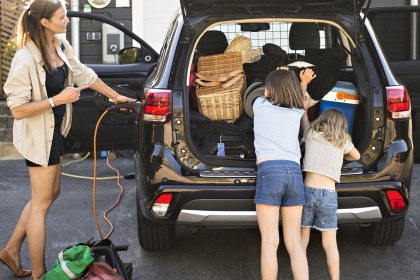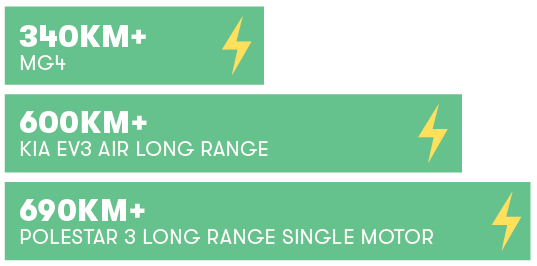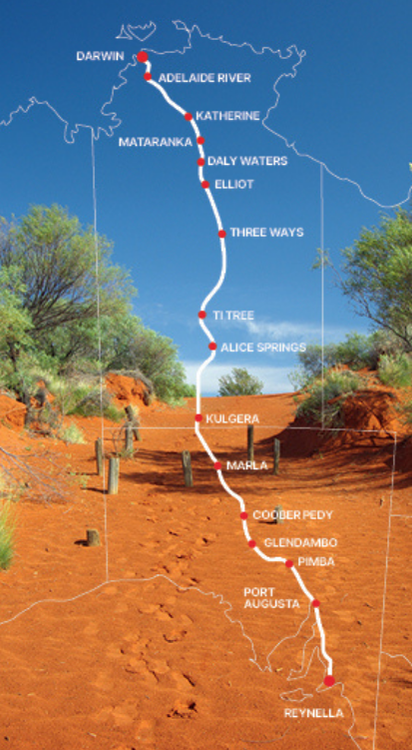
Electric vehicles are growing in popularity across Australia, but some drivers are still anxious about taking the plunge. Whether you’re ready to join the EV brigade, or still undecided, you want to base your choice on facts, not fiction.
We make your task easier by tackling a few myths.
When discussing electric vehicles – also known as EVs – it’s easy to have your opinion pulled in different directions. Your colleague says they don’t have a decent range. Your sister-in-law thinks EVs are too expensive. And your best friend thinks there aren’t enough public chargers in the Territory. Yet you’ve been noticing more EVs on the roads.
What to believe?
Electric Vehicle Council data shows sales of 91,000 battery-electric vehicles (BEVs) in Australia in 2024, plus 23,000 plug-in hybrid electric vehicles (PHEVs), accounting for about 10 per cent of new vehicle sales last year. Between January and June this year, EVs accounted for more than 12 per cent of all new car sales.
Despite these strong numbers, there are many EV myths floating around; let’s look at a few.
Myth 1: EVs cost too much
Like all vehicles, EVs vary in size, features and price. It’s still too early to say EVs have reached overall price parity with their internal combustion engine (ICE) equivalents, but EV prices have been trending downwards for years.
Australia’s cheapest EV – the BYD Dolphin Essential – is $29,990 plus on-road costs. Comparable ICE vehicles include the base model Mazda3, at $33,990, and the Toyota Corolla Ascent Sport hybrid, at $35,900.
If you want a small SUV, you can pick up a base-model Hyundai KONA Electric for about $56,800 plus on-road costs, while a top-of-the-range petrol SUV such as a Mazda CX-5 will set you back $53,700 and a Subaru Forester $51,540.
Expect to pay $100,000 plus for large and/or luxury EVs, but when you’re in the market for these types of vehicles, you may not be so price conscious.
Of course, price is only one aspect of car shopping. And with EVs, it’s important to offset a potentially higher up-front price with the significantly cheaper maintenance and running costs in the long term. Electricity is cheaper than petrol and diesel and EVs have fewer moving parts to maintain.
With so many new EV brands and models entering the Australian market, the price premium over ICE equivalents either no longer exists or has significantly reduced.
Don’t let the ‘EVs are too expensive’ mindset prevent you from considering one. You may find a suitable EV at a comparable or cheaper price than an ICE equivalent.
Myth 2: EVs have poor range
The Territory is a big place – it’s twice as big as France and five times the size of the UK. With vast distances between population centres, you’ll want to be sure your vehicle will get you to your destination.
You may have heard the term ‘range anxiety’, which is the fear of running out of charge and becoming stranded. It’s a legacy of the earlier days of EV ownership, because in the past few years, new technologies and other developments have diminished range anxiety for EV owners. These days, it’s not hard to find an EV with the range you need.
EV range depends on factors such as battery capacity, vehicle weight, your driving style and traffic. But as an example, the Polestar 3 Long Range travels up to 700km on a single charge, the same distance as Darwin to Daly Waters. The Kia EV3 Air Long Range has a range of about 600km, which compares with the Tesla Model 3 Long Range all-wheel-drive.
The base-model MG4 will take you about 350km, which roughly compares with the Hyundai Inster Extended Range.

If you want an EV as a runabout, or you live and work in Darwin, you’ll easily find one with an adequate range for your daily needs. But if you regularly travel longer distances, you’ll need an EV with a long-range battery. The good news is you’ll find plenty of options.
Secretary of the Australian Electric Vehicle Association (AEVA) NT Branch, Joseph Chin, says long trips in an EV are becoming
more common because of advanced technology and improved charging infrastructure.
“If you’re on a long trip, it’s important to take regular breaks, so plan them around charger locations,” Joseph says.
“While you’re having a coffee and a bite to eat, top up your EV and get some extra charge for the next part of your trip.”
Joseph says that with a bit of research and planning, EV owners can keep their vehicles adequately charged.
“Range anxiety is no reason to avoid an EV,” Joseph says.
Myth 3: There aren’t enough public chargers
EV range is irrelevant if there’s no place to charge it, right? Well, yes, but here’s some more good news.
There are about 62 EV charging sites across the NT, including 10 with fast and ultra-fast chargers that can boost an EV’s charge from 10 per cent to 80 per cent in 15-45 minutes.

AANT CEO Simon Matthias recently completed a four-day trip from Adelaide to Darwin in a Geely EX5 Inspire, which has a range of up to 410km.
Simon says he’d do the 3000km trip in an EV again in a heartbeat.
“I usually do this trip in three days, but this time I took it easy, averaging about 750km a day over four days,” Simon says.
“I expected hiccups and delays, maybe even getting stuck somewhere, but the trip was surprisingly easy and really enjoyable.”
During the trip, Simon charged his vehicle at more than 14 locations, including Port Augusta and Marla in South Australia, and Alice Springs, Daly Waters, Mataranka and Katherine in the NT. Simon says his longest distance between charges was about 340km.
“With smart driving and charging habits, I was able to complete the trip comfortably,” Simon says.
“Even when the battery was getting a bit low, I could slow down to save charge, so it wasn’t an issue.”
Simon says the Northern Territory is witnessing a growing enthusiasm for electric vehicles, driven not only by the promise of sustainability but also by significant fuel savings and cutting-edge technology.
“With increased public and private investment in charging infrastructure, the NT has an opportunity to cater to the changing demands of its community while also strengthening connections to the rest of the country.”
IMAGES: Getty/AANT.



